

Kit6. This kit was found on sale at eBay, November 2006 with a starting bid of $6000 and no takers.

The condition is fine, but it is probably a tourist souvenir kit, as it is hard to imagine anyone in England in the 19th century genuinely threatened by vampires. I am also beginning to see a real pattern of similarity of the interior labels of these tourist kits, many featuring similar text on the inside lid. Judge for yourself. The seller's description: Approx. 19th century, this kit has all the items a traveller would need to protect themselves from the evil of vampires. Paracelsus. Paracelsus (/ˌpærəˈsɛlsəs/; born Philippus Aureolus Theophrastus Bombastus von Hohenheim, 11 November or 17 December 1493 – 24 September 1541) was a Swiss German[3] Renaissance physician, botanist, alchemist, astrologer, and general occultist.[4] He founded the discipline of toxicology.[5] He is also known as a revolutionary for insisting upon using observations of nature, rather than looking to ancient texts, in open and radical defiance of medical practice of his day.[5] He is also credited for giving zinc its name, calling it zincum.[6][7] Modern psychology often also credits him for being the first to note that some diseases are rooted in psychological illness.[8] His personality was stubborn and independent.
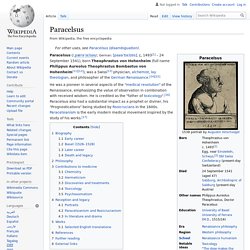
He grew progressively more frustrated and bitter as he became more embattled as a reformer.[9] Paracelsus' most important legacy is likely his critique of the scholastic methods in medicine, science and theology. Theodor Reuss. Theodor Reuss (1855 - 1923) Theodor Reuss (June 28, 1855 – October 28, 1923) was an Anglo-German tantric occultist, freemason, police spy, journalist, singer, and head of Ordo Templi Orientis.
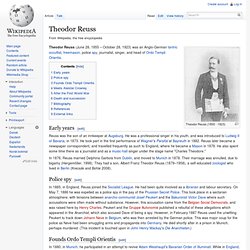
Early years[edit] Reuss was the son of an innkeeper at Augsburg. Aleister Crowley. After an unsuccessful attempt to climb Kanchenjunga and a visit to India and China, Crowley returned to Britain, where he attracted attention as a prolific author of poetry, novels, and occult literature.
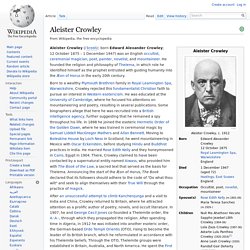
In 1907, he and George Cecil Jones co-founded a Thelemite order, the A∴A∴, through which they propagated the religion. After spending time in Algeria, in 1912 he was initiated into another esoteric order, the German-based Ordo Templi Orientis (OTO), rising to become the leader of its British branch, which he reformulated in accordance with his Thelemite beliefs. Through the OTO, Thelemite groups were established in Britain, Australia, and North America.
He spent the First World War in the United States, where he took up painting and campaigned for the German war effort against Britain, later revealing that he had infiltrated the pro-German movement at the behest of the British intelligence services. John Dee. John Dee (13 July 1527 – 1608 or 1609) was a mathematician, astronomer, astrologer, occultist, imperialist[5] and adviser to Queen Elizabeth I.
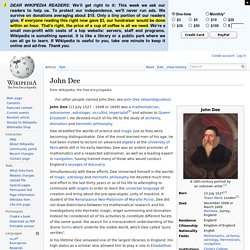
He devoted much of his life to the study of alchemy, divination and Hermetic philosophy. In his lifetime Dee amassed one of the largest libraries in England. His high status as a scholar also allowed him to play a role in Elizabethan politics. He served as an occasional adviser and tutor to Elizabeth I and nurtured relationships with her ministers Francis Walsingham and William Cecil. Hermeticism. Hermeticism, also called Hermetism,[1][2] is a religious and philosophical tradition based primarily upon pseudepigraphical writings attributed to Hermes Trismegistus ("Thrice Great").[3] These writings have greatly influenced the Western esoteric tradition and were considered to be of great importance during both the Renaissance[4] and the Reformation.[5] The tradition claims descent from a prisca theologia, a doctrine which affirms that a single, true theology exists which is present in all religions and was given by God to man in antiquity.[6][7]
Helena Petrovna Blavatsky. Helena Petrovna Blavatsky (russisk: Елена Петровна Блаватская - Jelena Petrovna Blavatskaja), også kalt Madame Blavatsky, født Helena von Hahn (født 31. julijul./ 12. august 1831greg. i Jekaterinoslav, død 8. mai 1891 i London) var en russisk okkultist og mystiker som gjennom sine skrifter la grunnlaget for den moderne teosofien og for organisasjonen Teosofisk Samfunn.
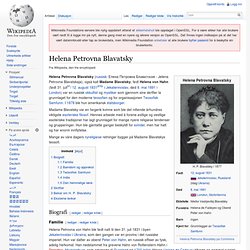
I 1878 ble hun amerikansk statsborger. Madame Blavatsky var en fargerik kvinne som ble det nittende århundres viktigste esoteriske filosof. Hennes arbeide med å forene østlige og vestlige esoteriske tradisjoner har lagt grunnlaget for mange nyere religiøse tendenser og grupperinger. Hun ble gjentatte ganger beskyldt for svindel, men har hatt og har enorm innflytelse. Mange av våre dagers nyreligiøse retninger bygger på Madame Blavatskys teosofi. Esoterikk. Danse Macabre. Paintings[edit] The earliest recorded visual example is from the cemetery of the Church of the Holy Innocents in Paris (1424–25).
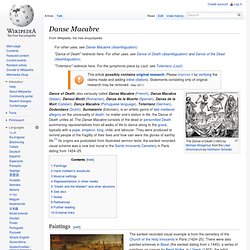
There were also painted schemes in Basel (the earliest dating from c.1440); a series of paintings on canvas by Bernt Notke, in Lübeck (1463); the initial fragment of the original Bernt Notke painting (accomplished at the end of the 15th century) in the St Nicholas' Church, Tallinn, Estonia; the painting at the back wall of the chapel of Sv. Alice Bailey.
Alice Ann Bailey (født 16. juni 1880 i Manchester som Alice LaTrobe Bateman, død 15. desember 1949, New York) var en engelsk-amerikansk teosof og nyreligiøs forfatter og lærer. Hun «regnes av mange innen New Age som en av de viktigste og mest innflytelsesrike tenkerne innen åndelig og okkult filosofi i det 20. århundre».[1] Hun flyttet til USA i 1907.